Facts About the Dwarf Planets
- Dwarf planets are different from planets because they have not cleared their orbital paths. Planets have enough gravity to push other smaller objects, but dwarf planets do not. what other interesting quick fire dwarf planet facts are there?
- There are currently only five official dwarf planets namely, Ceres, Pluto, Haumea, Makemake, and Eris. However, there are many other dwarf planet candidates like Gonggong, Orcus, Quaoar, Sedna, and Salacia.
- The dwarf planets were named after mythological characters. From Roman mythology, Pluto is the god of the underworld and Ceres is the goddess of grains. Haumea is the Hawaiian goddess of childbirth and fertility and Eris is the Greek goddess of childbirth and fertility. Makemake, from Rapa Nui mythology, is the god of fertility.
- Haumea has the strangest shape among the five dwarf planets. Because of its fast rotation, it ended up having a unique egg-like shape.
- Ceres is the nearest dwarf planet, the only one in the asteroid belt. It accounts for most of the mass in the asteroid belt. The other dwarf planets are in the Kuiper belt.
- While Pluto is the largest dwarf planet, Eris is the most massive. It is also the farthest from the Sun, it lies in the outer stretches of the Kuiper belt called the “scattered disk.”
- Just like planets, dwarf planets also have natural satellites. Pluto has five moons, Haumea has two, and Eris has one. Makemake has one provisional moon. Ceres is the only dwarf planet without a known moon.
- Dwarf planets can also have ring systems. The oddball, Haumea, has a ring surrounding it. It is the first object beyond Neptune’s orbit known to have a ring system.
- Dwarf planets mostly have relatively short days but very long years. A day on Haumea is only 4 hours long while a year on Eris takes 557 Earth years!
What Is a Dwarf Planet?
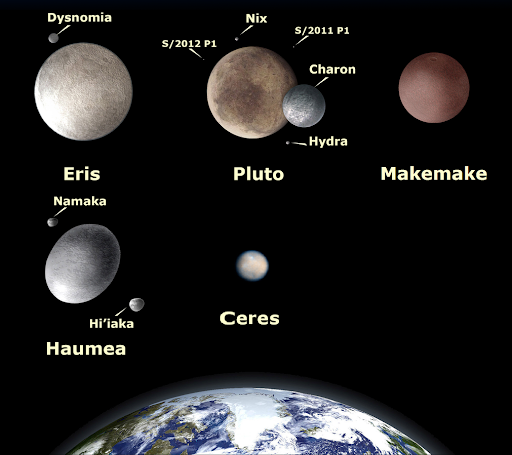
Dwarf planets are different from planets. They are a different class of objects that orbit the Sun. They are much smaller and are mostly located in the outer regions of the Solar System. This class of celestial objects was established by the International Astronomical Union (IAU) in 2006.
According to the IAU, a celestial body is classified as a dwarf planet if it exhibits the following characteristics:
- It is in orbit around the Sun;
- It has sufficient mass for its self-gravity to overcome rigid body forces so that it assumes a hydrostatic equilibrium (nearly round) shape;
- That It has not cleared the neighborhood around its orbit; and
- That It is not a satellite (a moon).
This definition of a dwarf planet differentiates it from a planet on two criteria: unlike the dwarf planet, a planet has cleared the neighborhood around its orbit, and the definition of a planet does not include the satellite distinction.
Origin of the Word
The planetary scientist Alan Stern coined the term “dwarf planet.” However, this term was invented under the category of planetary-mass objects. These objects were categorized into three: classical planets, dwarf planets, and satellite planets (planetary-mass moons).
The IAU adopted the term “dwarf planet” but, unlike Alan Stern, does not consider it under the planet category. Dwarf planets are a distinct class of objects that are completely different from planets.
Size of the Dwarf Planets
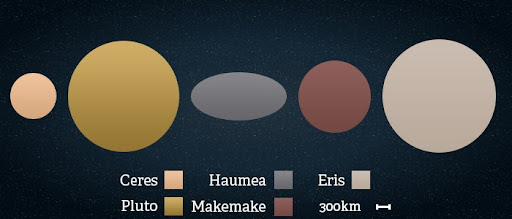
The largest dwarf planet is Pluto, followed by Eris, Makemake, Haumea, and Ceres being the smallest dwarf planet. Just slightly smaller in size than Pluto, Eris is the most massive of them all.
The order of the dwarf planets from closest to the Sun outwards is Ceres, Pluto, Haumea, Makemake, and Eris. Being the farthest, Eris is about 96.4 astronomical units (AU) from the Sun—almost 14 billion km (9 billion miles) away.
Trans-Neptunian Objects, Plutoids, and More
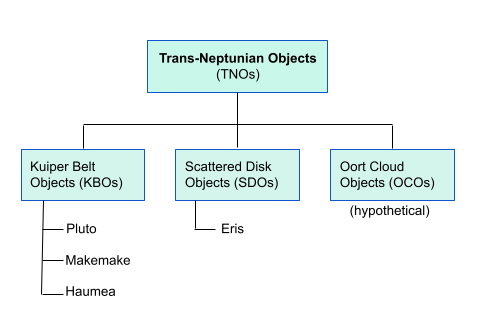
Astronomical bodies beyond the orbit of Neptune are called trans-Neptunian objects (TNOs). We can say that all dwarf planets except Ceres, which is in the asteroid belt, are all TNOs. That term includes all minor planets past Neptune.
As early as 2006, the IAU made Pluto a prototype of TNOs that is more exclusive among dwarf planets. They did not announce a name for this new group until 2008. Before that, these bodies were called “plutons” and even “plutonian objects.” The IAU finally announced that a dwarf planet located beyond Neptune is called a “plutoid.”
The trans-Neptunian space is divided into two: the Kuiper belt and the scattered disk. Pluto, Haumea, and Makemake are in the Kuiper belt while Eris lies in the more distant scattered disk.
Aside from the two, the third kind of TNOs could be from the hypothesized Oort cloud.
Dwarf Planets in Our Solar System
The IAU currently recognizes five dwarf planets in the Solar System. Since there are perhaps hundreds of similar bodies out there, we can only expect this list to grow. Some of the most probable dwarf planet candidates include Gonggong, Orcus, Quaoar, Sedna, Salacia, and 2002 MS4.
Let’s learn about the major dwarf planets: Ceres, Pluto, Haumea, Makemake, and Eris.
Ceres

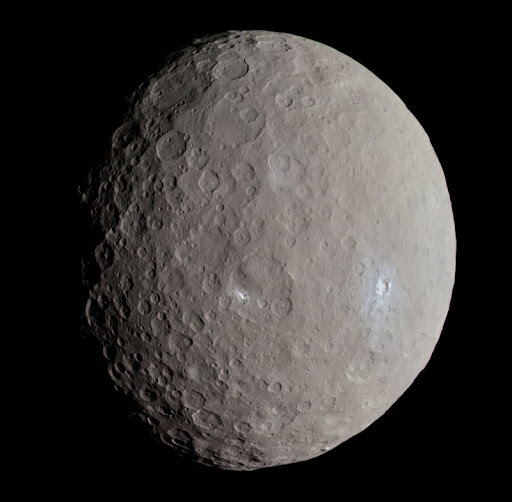
- MPC designation – (1) Ceres
- Discoverer – Giuseppe Piazzi
- Discovery Date – January 1, 1801
- Semi-major Axis – 2.8 AU
- Orbital Period – 4.61 Earth years
- Eccentricity – 0.08
- Inclination – 10.59° (to the ecliptic)
- Dimensions – 964.4 × 964.2 × 891.8 km
- Mean Radius – 476.2 km
- Rotation Period – 9 hours
- Surface Temperature – ≈110 to 235 K
- Apparent Magnitude – 6.64 to 9.34
The dwarf planet Ceres was discovered in January 1801 by the Italian astronomer Giuseppe Piazzi. It was named after the Roman goddess of agriculture. It lies 2.8 astronomical units (AU) from the Sun, in the asteroid belt.
A day on Ceres is only 9 hours long, and a year there takes 4.61 Earth years. It follows a nearly circular orbit that is tilted about 11°. With a mean radius of 476.2 km, it is the smallest of the five dwarf planets.
Ceres was thought to be a planet upon discovery. Since many objects similar to it were discovered, scientists made a different category and called it “asteroid.” It was the first object in the solar system to be considered an asteroid. It was reclassified as a dwarf planet when Pluto was reclassified to this category in 2006.
In 2015, NASA’s Dawn spacecraft arrived at Ceres. It made Ceres the first dwarf planet to be visited by a spacecraft. [Learn more facts about Ceres]
Pluto

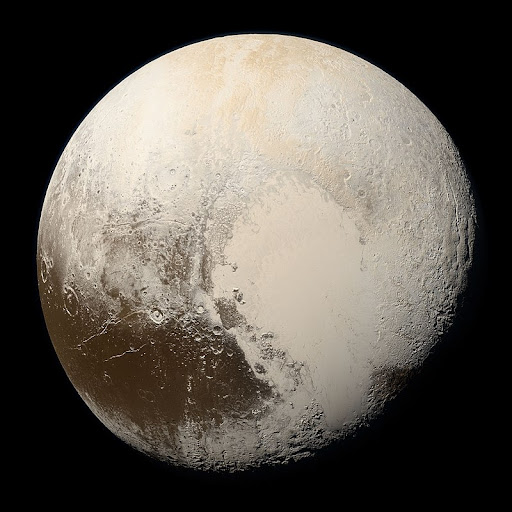
- MPC designation – (134340) Pluto
- Discoverer – Clyde W. Tombaugh
- Discovery Date – February 18, 1930
- Semi-major Axis – 39.482 AU
- Orbital Period – 247.94 Earth years
- Eccentricity – 0.2488
- Inclination – 17.16°
- Mean Radius – 1,188 km
- Rotation Period – 6 days and 9 hours
- Surface Temperature – ≈33 K to 55 K
- Apparent Magnitude – 15.1 (mean)
- Known Moon/s – Charon, Hydra, Kerberos, Nix, Styx
Pluto was discovered in February 1930 by American astronomer Clyde W. Tombaugh. It lies beyond the orbit of Neptune, about 39 AU from the Sun. That is, it is 39 times the distance of the Earth from the Sun. Sunlight takes about 5.5 hours to reach this distant world.
Pluto follows an elliptical and tilted orbit that is also chaotic. A year on this dwarf planet takes 248 Earth years and a day is roughly 153 hours. Just like Venus and Uranus, it spins from east to west, following a retrograde rotation.
Pluto was previously considered the ninth planet in the Solar System. However, after the 26th IAU General Assembly, the new “dwarf planet” category was established. It was stripped of the “planet” classification and is now among the recognized dwarf planets in the Solar System.
The New Horizons spacecraft did a successful flyby of Pluto in 2015. It took the first high-resolution image of this dwarf planet. It also revealed a lot about the Plutonian system and its moons. [Learn more facts about Pluto]
Haumea

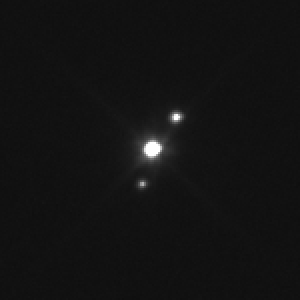
- MPC designation – (136108) Haumea
- Place of Discovery – Sierra Nevada Observatory
- Discovery Date – March 7, 2003
- Semi-major Axis – 43 AU
- Orbital Period – 283 Earth years
- Eccentricity – 0.19
- Inclination – 28°
- Mean Radius – ≈780 km
- Rotation Period – 4 hours
- Temperature – Less than 50 K
- Apparent Magnitude – 17.3
- Known Moon/s – Namaka, Hi’iaka
Haumea is an egg-shaped dwarf planet that lies past Neptune’s orbit in the Kuiper belt. Its discovery was disputed by two groups of astronomers. Because of that, the IAU only recognizes its place of discovery, not the individuals.
The name Haumea was inspired by Hawaiian mythology’s goddess of fertility and childbirth. Namaka and Hi’iaka, its moons, were named after the goddess’s daughters. Unlike Pluto and Ceres, no spacecraft has visited the Haumean system yet.
Haumea is 43 times as distant as the Earth is from the Sun. It is one of the fastest spinning large objects in the Solar System. This dwarf planet completes one rotation in only 4 hours. This fast rotation makes its shape elongated. A year in Haumea is equivalent to about 283 years on Earth.
Aside from the two moons, a ring system was also discovered in the system of Haumea. [Learn more facts about Haumea]
Makemake

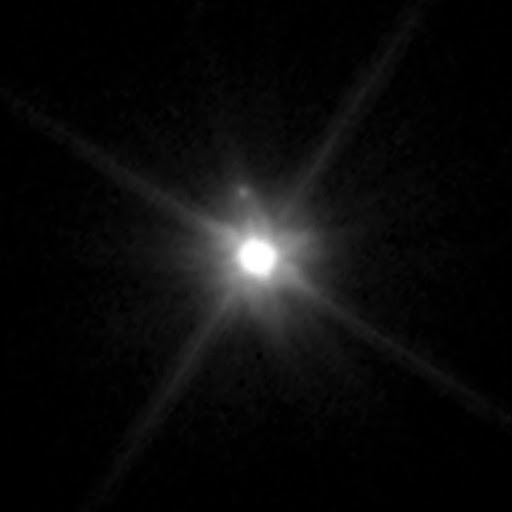
- MPC designation – (136472) Makemake
- Discoverers – Michael E. Brown, Chad Trujillo, David Rabinowitz
- Discovery Date – March 31, 2005
- Semi-major Axis – 45.43 AU
- Orbital Period – 305 Earth years
- Eccentricity – 0.16
- Inclination – 28.98°
- Mean Radius – 715 km
- Rotation Period – 22 hours 30 mins
- Surface Temperature – 40 K (average)
- Apparent Magnitude – 17.0
- Provisional Moon – S/2015 (136472) 1
Makemake is another dwarf planet located in the Kuiper belt. It was discovered in 2005 by a team of astronomers led by Michael Brown. Its discovery is one of the reasons for redefining planets and creating the “dwarf planet” classification.
The name Makemake was inspired by the god of fertility of the Rapa Nui people. After Pluto, Makemake is the second-brightest object in the Kuiper belt. It lies around 46 AU from the Sun. Roughly 1,430 km (889 mi) across, this dwarf planet is about 1/9 the radius of the Earth.
Makemake is a very cold world and the probability of life there is very low. A day on this dwarf planet is 22.5 hours long, roughly the same as Mars and Earth. It completes a trip around the Sun in 305 years.
In 2016, a small moon orbiting Makemake was detected by the Hubble Space Telescope. No spacecraft has visited the Makemake system yet. [Learn more facts about Makemake]
Eris

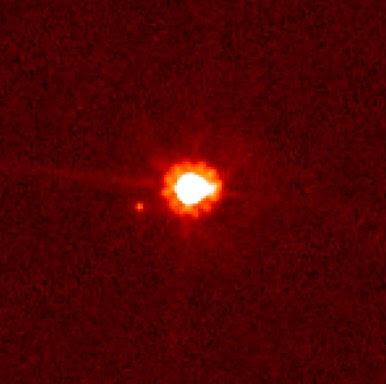
- MPC designation – (136199) Eris
- Discoverers – Mike Brown, Chadwick Trujillo, David Rabinowitz
- Discovery Date – January 5, 2005
- Semi-major Axis – 67.864 AU
- Orbital Period – 557 years
- Eccentricity – 0.43607
- Inclination – 44.040°
- Mean Radius – 1,163 km (723 mi)
- Rotation Period – 25.9 hours
- Surface Temperature – ≈ 42 K
- Apparent Magnitude – 18.7
- Known Moon/s – 1
Eris is the farthest dwarf planet from the Sun but also the most massive. It was discovered in 2005 by the same team that also discovered Makemake. It lies 68 AU from the Sun in the outer regions of the Kuiper belt called the “scattered disk.”
Eris follows an elliptical orbit that is very inclined at 44°. Its average radius is 1,163 km or 723 miles. It was once thought that it could be the 10th planet. However, it did not push through after the reclassification of Pluto. Because of its size, we can put all the objects in the asteroid belt inside this dwarf planet.
A day on Eris takes about 26 hours, slightly longer than here on Earth. However, a year there is much longer. It takes Eris 557 years to complete an orbit around the Sun. Though no direct flyby has been done on Eris yet, scientists believe that it may have a rocky surface.
Eris has no known ring system but it has one moon named Dysnomia. It is the second-largest moon to a dwarf planet, after Pluto’s Charon. With the discovery of methane on Eris, the surface of this dwarf planet is thought to be similar to that of Pluto. [Learn more facts about Eris]
Dwarf Planet Facts – Insights From the Dwarf Planets
No two dwarf planets are the same. By learning about these small worlds, we are also understanding more about the Solar System as a whole. The properties of these objects give us a peek into the nature of the planets, their moons, and other solar system bodies.
Below are some of the insights we have learned from the dwarf planets.
1. Dwarf Planets Hold Clues About the Early Solar System
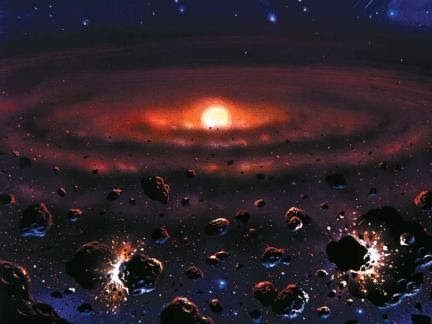
A close visit to Ceres in the asteroid belt revealed something about the past. Ammonia was discovered on its surface, however, this material is not abundant in the asteroid belt.
This tells us that Ceres may have formed in the outer solar system. It may have reached its current position after the migration of the gas giants pushed it inward. Another theory is that ammonia may have made its way into the inner system.
Unlike Ceres, the other dwarf planets have their own moons. These moons likely formed during the Late Heavy Bombardment when there were lots of collisions around. The giant planet migration likely caused this, sending celestial objects all over as they moved.
2. Pluto Helps Us Understand Neptune’s Orbit
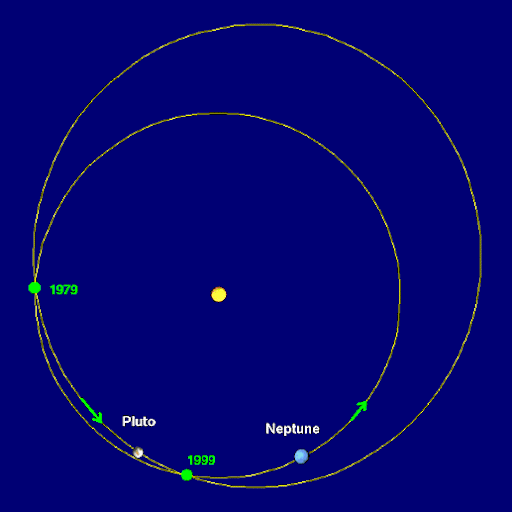
Pluto is in a 2:3 orbital resonance with Neptune. This resonance means that when Pluto makes two trips around the Sun, Neptune makes three. This is a cycle that takes about 495 years to unfold.
Pluto and Neptune follow stable paths and never collide, even though Pluto sometimes crosses the orbital path of Neptune. According to Renu Malhotra, a planetary scientist, this resonance could mean that these two bodies may have formed closer to the Sun before. When the gas giants migrated, Neptune perturbed Pluto and they eventually ended up in resonance with each other.
3. Ceres Tells Us Something About Icy Moons
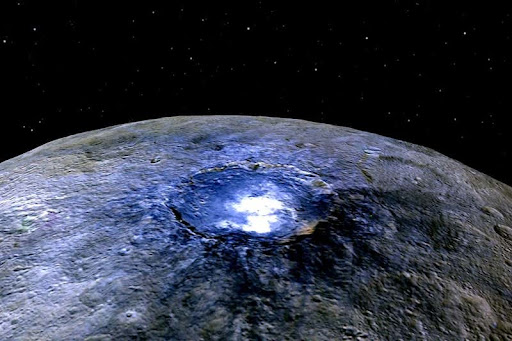
The bright and large Occator crater on Ceres may have an ocean beneath it.
Ceres has lots of water in it. Because of its size, this water is most likely frozen now. The brines that flow on its surface serve as evidence of this. Also, the Dawn mission discovered carbonates which could be evidence of a large ocean on this dwarf planet.
With the discovery of ammonia and carbonates, Ceres holds a lot of similarities with icy moons like Europa, Enceladus, and Titan. Ceres also shows cryovolcanism just like the icy ocean world of Enceladus. Because of its large amount of water ice, Ceres can be as potentially habitable as the famous icy moons.
4. Pluto Disproved the Existence of Planet X

The discovery of Pluto was largely due to Percival Lowell’s search for Planet X. Some even call it Planet 9. Its existence was speculated because of an effect on Uranus’s orbit other than that of Neptune.
When Pluto was discovered, estimates of its mass differed. At first, it was thought to be larger than Mercury. Its mass was finally measured through its moon Charon. As it turned out, Pluto was too small to have such effects on Uranus. Because of that, it can be agreed that Lowell’s Planet X does not really exist.
Pluto Reclassified as a Dwarf Planet

The enormity of the impact of this distinction between a planet and a dwarf planet had an immediate victim—Pluto.
Pluto was considered the ninth planet in the Solar System from its discovery in 1930 until 2006. With the new definition set by the IAU, it was stripped of that position and became a dwarf planet.
The main reason that relegated Pluto to dwarf planet status is that its orbit is riddled with other celestial objects that crisscross its path around the Sun. These objects include other celestial objects in the region outside the planet Neptune known as the Kuiper Belt.
Pluto and Eris, another dwarf planet, are actually part of the Kuiper Belt. In fact, the orbital paths of Eris and Pluto cross each other. In comparison, the orbits of the remaining eight planets do not contain other celestial bodies, and they never cross each other’s path.
Dwarf Planet Facts – History of the Dwarf Planet Classification

Pluto’s status as the ninth planet in the solar system began to unravel in August 1992. Astronomers at the University of Hawaii discovered more than a thousand objects orbiting the Solar System beyond Neptune. These objects were given the name Trans-Neptunian Objects (TNOs). They were of varying sizes and those that had been detected were smaller than Pluto.
In October 2003, astronomers at the Palomar Observatory in California identified a new trans-Neptunian object that was more massive than Pluto. This object also had a satellite and was initially named 2003 UB313. The discovery of 2003 UB313 led astronomers to believe that more of these massive objects existed. It also made them question whether 2003 UB313 could be considered a new planet or not.
The important question of what makes a celestial object a planet led the IAU to form a committee. This group was tasked with gathering the opinions of professionals from a wide range of interests including astronomers, educators, writers, and planetary scientists.

Based on the gathered opinions, the committee created a draft resolution on the definition of a planet. This draft proposal was then presented during IAU’s 2006 General Assembly in Prague. After much debate from its members, a revised version was then put to vote during the Closing Ceremony.
By the end of the General Assembly, the members had approved Resolution B5: Definition of a Planet in the Solar System. The Resolution also included the definition of a dwarf planet and thus created a new class that was distinct from planets.
Dwarf Planet Controversy
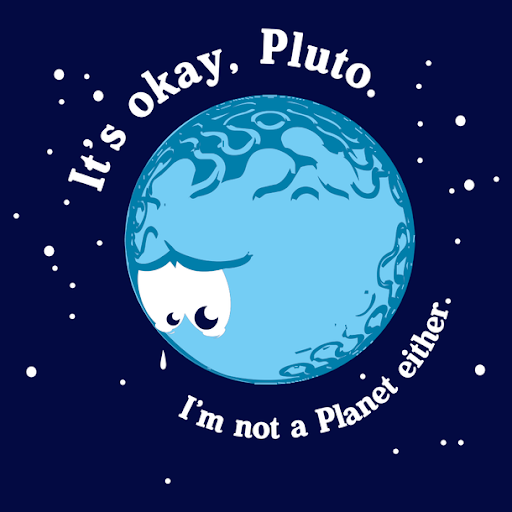
The resolution automatically made Pluto a dwarf planet. After the assembly, 2003 UB313 was given the name Eris. Pluto, Eris, and Ceres (an asteroid in the asteroid belt between the orbits of Mars and Jupiter) were the first members of the dwarf planet class. There are currently five recognized dwarf planets, with Makemake and Haumea joining the first three members.
The resolution that led to the classification of Pluto as a dwarf planet was not without its share of controversy. Some planetary scientists objected to the third criterion because they believed a planet, and therefore a dwarf planet, should be judged based on its intrinsic qualities. They think it is not about what is or isn’t in its neighborhood (orbital path).
Scientists opposed to the resolution believe that dwarf planets should be categorized as “true planets” in the same way that gas giants (e.g. Jupiter) and terrestrial planets (e.g. Earth) are considered “planets.”
More Interesting Dwarf Planet Facts
It’s time to round off our post but before we go, here are a few more interesting dwarf planet facts to tie things off. We hope you’ve enjoyed our post, and maybe even found it a little educational!
- The second-largest object in the asteroid belt, Vesta, may have been a dwarf planet once. However, it is no longer in hydrostatic equilibrium now because of impacts.
- Triton and Phoebe were also probably dwarf planets in the past. However, they are no longer orbiting the Sun as they were captured by Neptune and Saturn respectively.
- Pluto and its largest moon, Charon, could be a double dwarf planet. This is still being debated since there is no formal definition of a double/ binary dwarf planet yet.
- Charon and Pluto are mutually tidally locked to each other. With mutual tidal locking, both objects keep the same face toward the other. The Earth’s moon is another example of a tidally locked body. Our planet, however, is not tidally locked to it.
- In 2015, the Dawn spacecraft and New Horizons mission studied the systems of Ceres and Pluto respectively. So far, no other spacecraft has visited the other dwarf planets.
- Each dwarf planet is unique. Firstly, Ceres has mysterious bright spots. Pluto has a heart-shaped surface and Haumea is a fast-spinning large body. Makemake has a volatile surface, while Eris, the farthest, may have an icy surface.
If you liked our post on Dwarf Planet facts, why not check out our post on 50 incredible space facts!
Dwarf Planet Facts – Sources:
https://en.wikipedia.org/wiki/Dwarf_planet#History_of_the_concept
https://solarsystem.nasa.gov/planets/dwarf-planets/makemake/in-depth/
https://en.wikipedia.org/wiki/Scattered_disc#Subdivisions_of_trans-Neptunian_space
https://solarsystem.nasa.gov/planets/overview/
(https://eos.org/articles/six-things-dwarf-planets-have-taught-us-about-the-solar-system)
https://www.space.com/15216-dwarf-planets-facts-solar-system-sdcmp.html
Dwarf Planet Facts – Image Sources:
https://d2pn8kiwq2w21t.cloudfront.net/images/infographicsuploadsinfographicsfull11268.width-768.jpg
5 dwarf planets: https://upload.wikimedia.org/wikipedia/commons/thumb/0/09/Dwarfplanets5.png/1011px-Dwarfplanets5.png
Ceres: https://upload.wikimedia.org/wikipedia/commons/thumb/7/76/Ceres_-_RC3_-_Haulani_Crater_%2822381131691%29_%28cropped%29.jpg/800px-Ceres_-_RC3_-_Haulani_Crater_%2822381131691%29_%28cropped%29.jpg
Ceres symbol: https://upload.wikimedia.org/wikipedia/commons/thumb/c/ca/Ceres_symbol.svg/800px-Ceres_symbol.svg.png
Pluto astronomical symbol: https://upload.wikimedia.org/wikipedia/commons/thumb/f/ff/Pluto_symbol.svg/800px-Pluto_symbol.svg.png
Pluto: https://upload.wikimedia.org/wikipedia/commons/thumb/e/ef/Pluto_in_True_Color_-_High-Res.jpg/800px-Pluto_in_True_Color_-_High-Res.jpg
Haumea astronomical symbol: https://upload.wikimedia.org/wikipedia/commons/thumb/3/3f/Haumea_symbol_%28Moskowitz%2C_fixed_width%29.svg/800px-Haumea_symbol_%28Moskowitz%2C_fixed_width%29.svg.png
Haumea: https://upload.wikimedia.org/wikipedia/commons/2/2b/Haumea_Hubble.png
Makemake astronomical symbol: https://upload.wikimedia.org/wikipedia/commons/thumb/b/bb/Makemake_symbol_%28Moskowitz%2C_fixed_width%29.svg/800px-Makemake_symbol_%28Moskowitz%2C_fixed_width%29.svg.png
Makemake: https://upload.wikimedia.org/wikipedia/commons/2/29/Makemake_and_its_moon.jpg
Eris and Dysnomia: https://upload.wikimedia.org/wikipedia/commons/5/5b/Eris_and_dysnomia2.jpg
Eris astronomical symbol: https://upload.wikimedia.org/wikipedia/commons/thumb/7/77/Eris_symbol.svg/800px-Eris_symbol.svg.png
Solar nebula: https://earthandsolarsystem.files.wordpress.com/2012/01/solarnebula.jpg
Pluto and Neptune’s orbits: http://www.pas.rochester.edu/~blackman/ast104/pluto-neptune.gif
Occator Crater: https://images.newscientist.com/wp-content/uploads/2020/08/10143522/10-aug_ceres-ocean.jpg?width=800
Pluto through the years: https://solarsystem.nasa.gov/system/resources/detail_files/928_pluto-observations-through-the-years.gif
Pluto gets the call: https://giphy.com/gifs/books-planets-pluto-eNpc1HmLth5DgYRa3z
Voting on the planets: https://upload.wikimedia.org/wikipedia/commons/thumb/6/63/Planet_Voting_IAU2006GA.jpg/1200px-Planet_Voting_IAU2006GA.jpg
IAU members vote:
https://s.hdnux.com/photos/12/07/43/2652385/9/rawImage.jpg
Dwarf planet controversy: https://s3.ap-south-1.amazonaws.com/247-post/img/05351af0-40b7-11e9-92af-a9c065821767.png